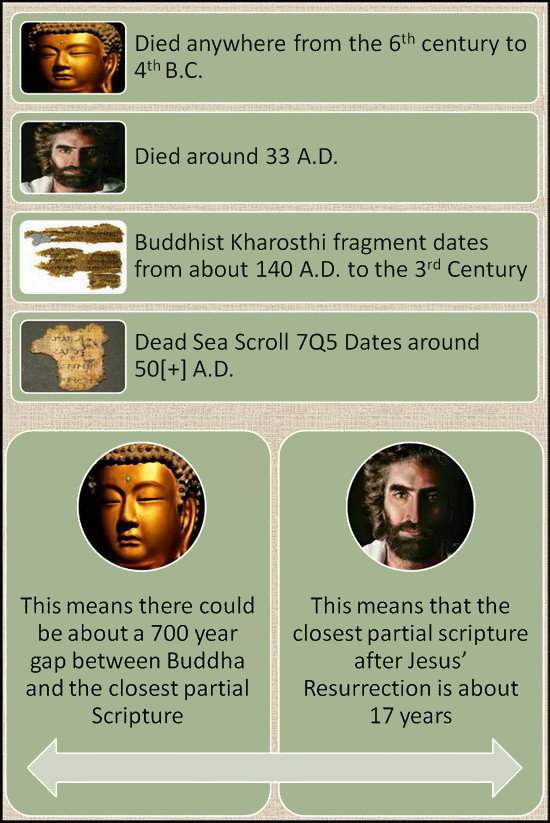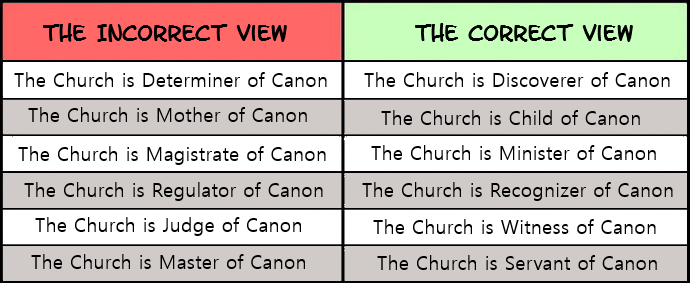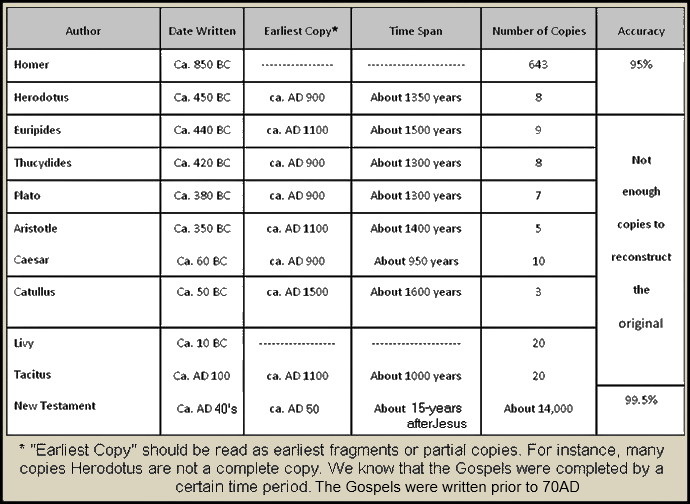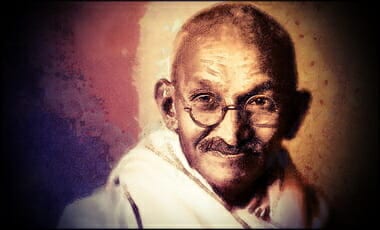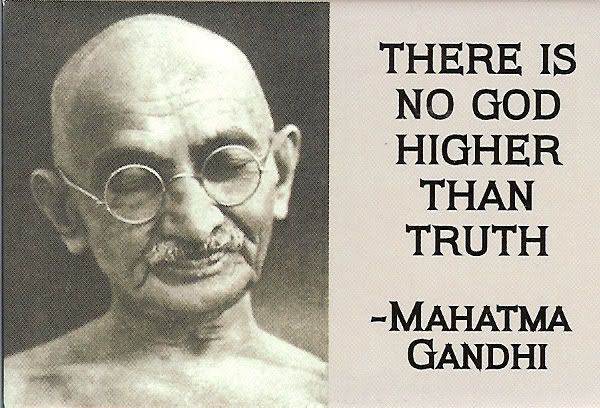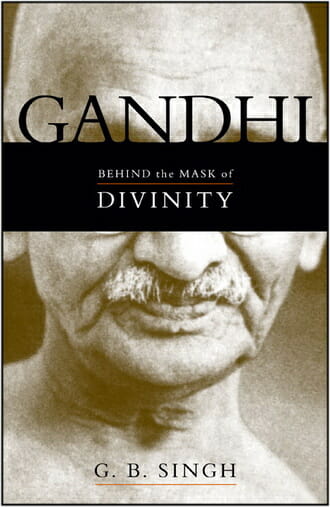(Originally posted November 2014)
(JUMP TO COMPARISON OF MANUSCRIPTS)
BUDDHIST ETHICS
LOVE? COMPASSION?
I want to suggest that the Lama’s use of “love” and “compassion” are not found in Buddhism, but used in the Judeo-Christian sense (borrowed in other words) because Eastern metaphysics lack such thought. The Dalai Lama may do this out of ignorance of his own belief, or out of wanting to pull on Western heart strings of compassion (honed itself by the Judeo-Christian ethic), which is often followed by monetary support. Here is a discussion I had with a Buddhist apologist about such thinking, it is taken from my chapter, REINCARNATION VS. LAWS OF LOGIC:
My initial engagement:
Does the idea of “violence” as a moral good or bad truly exist in the Buddhist mindset? What I mean is that according to a major school of Buddhism, isn’t there a denial that distinctions exist in reality… that separate “selves” is really a false perception? Language is considered something the Buddhist must get beyond because it serves as a tool that creates and makes these apparently illusory distinctions more grounded, or rooted in “our” psyche. For instance, the statement that “all statements are empty of meaning,” would almost be self refuting, because, that statement — then — would be meaningless. So how can one go from that teaching inherent to Buddhistic thought and say that self-defense (and using WWII as an example) is really meaningful. Isn’t the [Dalai] Lama drawing distinction by assuming the reality of Aristotelian logic in his responses to questions? (He used at least three Laws of Logic [thus, drawing distinctions using Western principles]: The Law of Contradiction; the Law of Excluded Middle; and the Law of Identity.) Curious.
They Call Him James Ure, responds:
You’re right that language is just a tool and in the end a useless one at that but It’s important to be able run a blog. That or teach people the particulars of the religion. It’s like a lamp needed to make your way through the dark until you reach the lighthouse (Enlightenment, Nirvana, etc.) Then of course the lamp is no longer useful unless you have taken the vow to teach others. Which in my analogy is returning into the dark to bring your brothers and sisters along (via the lamp-i.e. language) to the lighthouse (enlightenment, Nirvana, etc.)
I respond:
Then… if reality is ultimately characterless and distinctionless, then the distinction between being enlightened and unenlightened is ultimately an illusion and reality is ultimately unreal. Whom is doing the leading? Leading to what? These still are distinctions being made, that is: “between knowing you are enlightened and not knowing you are enlightened.” In the Diamond Sutra, ultimately, the Bodhisattva loves no one, since no one exists and the Bodhisattva[a][b] knows this:
- “All beings must I lead to Nirvana, into the Realm of Nirvana which leaves nothing behind; and yet, after beings have been led to Nirvana, no being at all has been led to Nirvana. And why? If in a Bodhisattva the notion of a “being” should take place, he could not be called a “Bodhi-being.” And likewise if the notion of a soul, or a person should take place in him. (Diamond Sutra, Sura 14)
So even the act of loving others, therefore, is inconsistent with what is taught in the Buddhistic worldview, because there is “no one to love.” This is shown quite well (this self-refuting aspect of Buddhism) in the book, The Lotus and the Cross: Jesus Talks with Buddha (Ravi), a book I recommend with love, from a worldview that can use the word love well.
[BTW, Ravi contradicted God’s ideals / character, where Christian ethics have a root in and gain their sustenance from. Neither did Ravi do any damage to the theistic argument of ethics regarding the Judeo-Christian foundations in God’s nature. We can say that Ravi’s actions were in fact wrong. Ethically. In Buddhism the posit would be — ultimately — an illusion/delusion, so ethics is likewise — in the end — an illusory position.. Not only that, but Buddhism would note that the victims in Ravi’s reach previous karmic lives demand that their abuse were to happen.]
One writer puts it thusly: “When human existence is blown out, nothing real disappears because life itself is an illusion. Nirvana is neither a re-absorption into an eternal Ultimate Reality, nor the annihilation of a self, because there is no self to annihilate. It is rather an annihilation of the illusion of an existing self. Nirvana is a state of supreme bliss and freedom without any subject left to experience it.”
My Final Response:
I haven’t seen a response yet. Which is fitting… because whom would be responding to whom? Put another way, would there be one mind trying to actively convince the other mind that no minds exist at all?
Here’s another way to see the same thing, Dan Story weighs in again:
- Here’s another way to see the same thing. It may be possible that nothing exists. However, it is impossible to demonstrate that nothing exists because to do so would be to deny our own existence. We must exist in order to affirm that reality doesn’t exist. To claim that reality is an illusion is logically impossible because it also requires claiming that the claim itself is unreal—a self-defeating statement. If reality is an illusion, how do we know that pantheism isn’t an illusion too?[1]
Another author put it thusly, “if pantheism is true (and my individuality an illusion), it is false, since there is no basis by which to explain the illusion.”[2] The challenge then becomes this: “if reality is an illusion, how do we know then that pantheism isn’t an illusion as well?”[3]
[1] Dan Story, Christianity on the Offense, 112-113.
[2] Francis J. Beckwith and Stephen E. Parrish, See the Gods Fall: Four Rivals to Christianity (Joplin, MO: College Press, 1997), 210.
[3] Dan Story, Christianity on the Offense, 112-113.
[a] “One who has taken a vow to become a Buddha.” David Burnett, The Spirit of Buddhism: A Christian Perspective on Buddhist Thought (Grand Rapids, MI: Monarch Books, 2003), 329.
[b] “Celestial” Buddha’s and bodhisattvas are said to be able to assist in guiding believers towards salvation as supernatural beings. These bodhisattvas vary in their rolls and offices as the many gods of Hinduism, from which Buddhism comes. See: Michael D. Coogan, Eastern Religions: Hinduism, Buddhism, Toaism, Confucianism, Shinto (New York, NY: Oxford University Press, 2005), 133-139.
Ultimately, if you show love to a spouse, a child — or compassion towards animals, you are participating in the illusion that has you stuck in a “karma loop,” so-to-speak. On top of that, the Bodhisattva [the Dalai Lama] shouldn’t want “humanity to survive,” he is trying to guide them to extinction.
This excerpt of Dallas Theological Seminaries presentation by Timothy Tennent is to compliment my post on Buddhism. Dr. Timothy Tennent, President of Asbury Seminary in Wilmore, KY, talks about Buddhism, its high regard for compassion and ethics, and how Christians can have a conversation about religion and faith. (See FULL VIDEO)
One of my very favorite quotes deals with the founders of the great religions and the consistency found in these founders:
The nine founders among the eleven living religions in the world had characters which attracted many devoted followers during their own lifetime, and still larger numbers during the centuries of subsequent history. They were humble in certain respects, yet they were also confident of a great religious mission. Two of the nine, Mahavira and Buddha, were men so strongminded and self-reliant that, according to the records, they displayed no need of any divine help, though they both taught the inexorable cosmic law of Karma. They are not reported as having possessed any consciousness of a supreme personal deity. Yet they have been strangely deified by their followers. Indeed, they themselves have been worshiped, even with multitudinous idols. All of the nine founders of religion, with the exception of Jesus Christ, are reported in their respective sacred scriptures as having passed through a preliminary period of uncertainty, or of searching for religious light. Confucius, late in life, confessed his own sense of shortcomings and his desire for further improvement in knowledge and character. All the founders of the non-Christian religions evinced inconsistencies in their personal character; some of them altered their practical policies under change of circumstances. Jesus Christ alone is reported as having had a consistent God-consciousness, a consistent character himself, and a consistent program for his religion. The most remarkable and valuable aspect of the personality of Jesus Christ is the comprehensiveness and universal availability of his character, as well as its own loftiness, consistency, and sinlessness.
Robert Hume, The World’s Living Religions (New York, NY: Charles Scribner’s Sons, 1959), 285-286.
An example of a self-refuting/incoherent worldview that deals a bit with Eastern philosophy/religion comes from A Handbook for Christian Philosophy, by L. Russ Bush. After giving a basic definition of what a worldview is,[1] Dr. Bush goes on to explain how differing worldviews can interpret reality and then he applies some first principles to the matter:
…most people assume that something exists. There may be someone, perhaps, who believes that nothing exists, but who would that person be? How could he or she make such an affirmation? Sometimes in studying the history of philosophy, one may come to the conclusion that some of the viewpoints expressed actually lead to that conclusion, but no one ever consciously tries to defend the position that nothing exists. It would be a useless endeavor since there would be no one to convince. Even more significantly, it would be impossible to defend that position since, if it were true, there would be no one to make the defense. So to defend the position that nothing exists seems immediately to be absurd and self-contradictory.[2]
[1] “A worldview is that basic set of assumptions that gives meaning to one’s thoughts. A worldview is the set of assumptions that someone has about the way things are, about what things are, about why things are.” L. Russ Bush, A Handbook for Christian Philosophy (Grand Rapids, MI: Zondervan, 1991), 70.
[2] Ibid.
I will say here that Buddhism and Christianity agree that the proper relation in a marriage situation is a male and female. But many “Western “adherents” to Buddhism do not know what they are saying when statements are made about Buddhism being “such-and-such.” Two short videos are perfect for setting up an excerpt from my book:
So here is a portion of my chapter dealing with Eastern Thought:
Pantheism
Now that we have defined what the Law of Noncontradiction is, lets apply it to some basic Eastern thinking. All Hindus, Buddhists, New Agers (etc), are pantheists. The term Pantheist “designates one who holds both that everything there is constitutes a unity and that this unity is divine.” Most pantheists (Hindus, Buddhists, New Agers, etc.) would hold that physical reality, and all the evils it produces, is merely an illusion. This holds true for the personality of man as well. This distinction explains why, in both Hinduism and Buddhism, the personality is seen as an “enemy” and is finally destroyed by absorption into Brahmin or Nirvana. Not only is the material creation absorbed, but human existence are either an illusion, as in Hinduism (maya), or so empty and impermanent, as in Buddhism (sunyata), that they are ultimately meaningless.
But is an impersonal “immortality” truly meaningful when it extinguishes our personal existence forever? Is it even desirable? As Sri Lanken Ajith Fernando, who has spoken to hundreds of Buddhists and Hindus, illustrates:
“When I asked a girl who converted from Buddhism to Christianity through our ministry what attracted her to Christianity, the first thing she told [me] was, ‘I did not want Nirvana.’ The prospect of having all her desires snuffed out after a long and dreary climb [toward ‘liberation’] was not attractive to her.”
In the end, man himself is a hindrance to spiritual enlightenment and must be “destroyed” to find so called “liberation.” As Dr. Frits Staal comments in an article entitled, “Indian Concepts of the Body,” “Whatever the alleged differences between Hindu and Buddhist doctrines, one conclusion follows from the preceding analysis. No features of the individual[‘s] personality survive death in either state”
With the above in mind, take note of a major problem that faces the pantheist visa viz, “that there is no reality except the all-encompassing ‘God’.” Using the Law of Noncontradiction we can see that this is a nonsensical statement that is logically self-refuting. If everything is illusion, then those making that statement are themselves illusions. There’s a real problem here. As Norman Geisler pointed out, “One must exist in order to affirm that he does not exist.” When we claim that there is no reality except the all-encompassing God, we are proving just the opposite. The fact that we exist to make the claim demonstrates that there is a reality distinct from God, which makes this key doctrine of pantheism a self-defeating proposition. It is an untruth – by definition.
Reincarnation
Another belief that is accepted by all Eastern philosophies as well as the New Age movement is that of reincarnation. I will explain the concept with some examples, after I define the term. Reincarnation is a “belief in the successive rebirth of souls into new bodies, as the soul progresses toward perfection.”
Some examples of this “karmic law” are warranted: first, lets assume I beat and abused my wife horribly, treated her like the dirt on my shoes, I would be storing up some pretty bad karma. When I come around for my next human life, after, of course, traveling through the insect, and animal lives, I would come back as the woman being beat. This is karma’s answer to evil, which is really no answer at all. In fact, it perpetuates evil. How so? It necessitates a “beatee,” which mandates a “beater.” Karma, then, creates a never-ending circle of violence, or, “evil.” In addition it states (emphatically I might add) that we choose our current destiny (or events) in this life due to past life experiences and choices. This is why the holy men in Buddhist and Hindu nations generally walk right by the maimed, injured, starving, and uneducated, and do not care for them. This next true story drives this point home.
While speaking in Thailand, Ron Carlson was invited to visit some refugee camps along the Cambodian border. Over 300,000 refugees were caught in a no-man’s-land along the border. This resulted from the Cambodian massacre under Pol Pot and the Khmer Rouge in the mid-70’s (which is known as the “killing fields”) and then subsequently by the invasion of the Vietnamese at the end of the 70’s. One of the most fascinating things about these refugee camps was the realization of who was caring for the refugees. Here, in this Buddhist country of Thailand, with Buddhist refugees coming from Cambodia and Laos, there were no Buddhists taking care of their Buddhist brothers. There were also no Atheists, Hindus, or Muslims taking care of those people. The only people there, taking care of these 300,000[+] people, were Christians from Christian mission organizations and Christian relief organizations. One of the men Ron was with had lived in Thailand for over twenty-years and was heading up a major portion of the relief effort for one of these organizations. Ron asked him: “Why, in a Buddhist country, with Buddhist refugees, are there no Buddhists here taking care of their Buddhist brothers?” Ron will never forget his answer:
“Ron, have you ever seen what Buddhism does to a nation or a people? Buddha taught that each man is an island unto himself. Buddha said, ‘if someone is suffering, that is his karma.’ You are not to interfere with another person’s karma because he is purging himself through suffering and reincarnation! Buddha said, ‘You are to be an island unto yourself.’” – “Ron, the only people that have a reason to be here today taking care of these 300,000 refugees are Christians. It is only Christianity that people have a basis for human value that people are important enough to educate and to care for. For Christians, these people are of ultimate value, created in the image of God, so valuable that Jesus Christ died for each and every one of them. You find that value in no other religion, in no other philosophy, but in Jesus Christ.” [Ron Carlson & Ed Decker, Fast Facts on False Teachings (Eugene, OR: Harvest House, 1994), 28-29.]
Do you get it now? It takes a “Mother Teresa” with a Christian worldview to go into these embattled countries and bathe, feed, educate, care for these people – who otherwise are ignored due to harmful religious beliefs of the East.
Another example is a graphic one, but it drives the point home. While at home on my day off, my work calls me in due to an emergency. I cannot find a sitter for my youngest son, so I call a family member, say, uncle Steve. While I am at work, uncle Steve rapes and sodomizes my son. Should I call the authorities?? If I am a believer in reincarnation, then I must realize that this “evil” is an illusion, number one, and number two, this “evil” was brought on my son most likely because of something my son did in a previous incarnation. Something my son did in a previous lifetime demands that this happened to him in this lifetime. (Or something I did, or my wife did, whomever.) Only recently have some Indian people rejected reincarnation and started to kill the massive infestation of disease-ridden rodents that inhabit India’s cities. These rodents carry and transmit many diseases as well as destroying and infecting large portions of food that could have made it to the starving population. Most, however, continue to nurture or ignore these disease-carrying animals in the belief that they are a soul stuck in the cosmic wheel. This is just one example of a horrible religious practice that is part of the many destructive practices that are hurting precious people. The caste system mentioned before is another that promotes and encourages racism, malnourishment, lack of education, and death….
What’s The Difference Between Christianity… and Buddhism
The longer version of this can be found HERE. Here is THAT description:
- (September 3, 2012) Ravi Zacharias responds with “precise language” to a written question. With his patented charm and clarity, Ravi responds to the challenge of “exclusivity in Christianity” that skeptics seem to think is exclusive to our faith. This is one of Ravi’s best.
Here is my slightly adapted script of this upload:
(MY POSITION ON RAVI IS ENCAPSULATED BY ACTS 17 APOLOGETICS)
Here is my adapted transcript of the above:
Many people like to criticize Christianity’s arrogant exclusivity, they will say that if the end result is to be good, how could I embrace a faith that claims to be the only true way?
This is the perceived problem with exclusivity. How can there be only one way to God?
The answer with the post-modernist when they raise this question of the Christian faith is that the post-modernist has not again examined his or her own question. It is not only the Christian faith that claims to be exclusive.
- Islam claims exclusivity.
- Buddhism claims exclusivity.
- Sikhism claims exclusivity.
- Hinduism claims exclusivity.
- All religions claim exclusivity at some point in their philosophy.
Gautama Buddha was born a Hindu. He rejected Hinduism on two major accounts.
(1) Hinduism assumes, for example, that the Vedas are the ultimate revelation, and in that sense their inerrant scriptures. Buddha rejected the Veda.
(2) Hinduism claims the caste system on the hierarchy of human birth. Gautama Buddha rejected the caste system.
Two principal beliefs of Hinduism, the Vedas and the caste system, Gautama Buddha completely rejected. That’s why even in recent times you will hear Hindu leaders sometimes getting disgruntled with Hinduism because of the caste system and the hierarchical system of human birth that is attributed to it.
Now, what did Gautama Buddha do in its place? He changed the notion of self from Hinduism into no essential self. In Buddhism he changed even the idea of reincarnation, what reincarnation actually means.
All this to say it is not true that Christianity is the only exclusive claim every major religion claim exclusivity. The Bahais are the only so-called all inclusivist, but even they exclude the exclusivists.
Life vs. Death |or| Christianity vs. Buddhism
(The original file I used is HERE)
manuscript comparisons
So to say the Dalia Lama or the Buddha are “Christ like” is to wholly misunderstand the chasm of differences in the two completely different leaders of these religions… and their logical conclusions. Also worth noting is that the date between writings, and so the possibility of corruption of the text is vastly different between the two faiths. For instance, the Buddha is said to have dies around (using the earliest date) 400 B.C..
The earliest portion of a Buddhist writing is dated at about 179 A.D. So let us compare this:
References for the above dating of the Buddhist fragments:
- Richard Salomon, Ancient Buddhist Scrolls from Gandhara: The British Library Kharosthi Fragments (PDF summation, book);
- Ingo Strauch, The Bajaur collection: A new collection of Kharoṣṭhīmanuscripts: A preliminary catalogue and survey (PDF).
DIAMOND SUTRA COMPARED TO BOOK OF JOHN
The most complete copy that dates early is the Gospel of John (Bodmer Papyrus II – 150-200 A.D.). That is 127 years after Christ, for the Gospel of John. The earliest fragment is dated to 120 A.D. And Clement of Rome quoted from it about 95 A.D., and Polycarp quoted from it around 110 A.D. [+]. So we KNOW John is older.
The oldest full book key to Buddhist thought is the Diamond Sutra, dated at about 868AD. That is 1,268-to-1,468 years after Buddha’s death. We KNOW the Diamond Sutra is older… but the fragments and quotes of the Gospel of John match up well with earliest text. The earlier quotes of the Diamond Sutra and it’s fragments show drastic change.
Another example. The earliest copy of Isaiah the church had was dated to about 900AD. They found a copy of Isaiah dated to 1,200 years earlier. Because of how the Jewish scribes copied text… there were only a few letters in the entirety of the text that were different. Most were in a word known to be “light” No meaning or concept was changed in those letters being different. (Sources: here, here, and here.)
The change in meaning in the Diamond Sutra from earlier Buddhist teaching as well as fragments is great:
Since at least the fifth century, generations of Buddhists have memorized and chanted the Diamond Sutra, a short Mahayana Buddhist scripture. The work, which offers meditations on illusion and perception, was originally written in Sanskrit and first translated into Chinese in 402 A.D. Despite the text’s longevity, Stanford religious studies professor Paul Harrison’s latest research suggests that previous translations may have incorrectly interpreted certain words in a way that affects the entire meaning of the text.
For the last seven years Prof. Harrison has been working on re-editing and re-translating the Diamond Sutra. Though he is a professor of religious studies his translation work falls squarely in the field of philology. Harrison is often surrounded by a large semicircle of previous translations and dictionaries that he consults as he combs through the sutra one word at a time.
The Diamond Sutra is one of the most historically important texts in the Buddhist faith, in part because a copy of it is the oldest surviving dated printed book in the world (868 A.D.). Also known by its Sanskrit title Vajracchedika, the Diamond Sutra posits that something is what it is only because of what it is not. The text challenges the common belief that inside each and every one of us is an immovable core, or soul—in favor of a more fluid and relational view of existence. Negative, or seemingly paradoxical statements by the Buddha abound in the text, such as “The very Perfection of Insight which the Buddha has preached is itself perfection-less.”
Professor Harrison elaborated, “I think the Diamond Sutra is undermining our perception that there are essential properties in the objects of our experience….
(Source: here)
I write about the early attestation to the New Testament in the first 16-pages of my chapter on Gnosticism and Feminism. But I reworked Kenneth Boa’s graphic on comparing dating of ancient texts with some updated information not only cataloged via the aforementioned chapter from my book, but also from here, and the books:
- Norman L. Geisler, Baker Encyclopedia of Christian Apologetics (Grand Rapids, MI: Baker Books/Academic, 1999);
- Carsten Peter Theide and Matthew d’Ancona, The Jesus Papyrus: The Most Sensational Evidence on the Origins of the Gospels Since the Discovery of the Dead Sea Scrolls (New York, NY: Galilee DoubleDay, 1996).
(I edited the last column under “Date Written” and “Time Span”)
Below is some of the evidence for the early dating of the New Testament.
More on this from Dr. Geisler:
[DSS stands for Dead Sea Scrolls]
….Light on the New Testament. Some DSS fragments have been identified as the earliest known pieces of the New Testament. Further, the messianic expectations reveal that the New Testament view of a personal messiah-God who would rise from the dead is in line with first-century Jewish thought.
The New Testament fragments? Jose *O’Callahan, a Spanish Jesuit paleographer, made headlines around the world in 1972 when he announced that he had translated a piece of the Gospel of Mark on a DSS fragment. This was the earliest known piece of Mark. Fragments from cave 7 had previously been dated between 50 B.C. and A.D. 50 and listed under “not identified” and classified as “Biblical Texts.” O’Callahan eventually identified nine fragments. The center column in the following chart uses the numbering system established for manuscripts. For example, “7Q5” means fragment 5 from Qumran cave 7.
[RPT’s Note: 7Q5 matches up well with Mark 6:52-53 ~ see below, sources for graphic: here, here, as well as this chapter and the aforementioned books.]
Both friend and critic acknowledged from the beginning that, if valid, O’Callahan’s conclusions would revolutionize current New Testament theories. The New York Times reported: “If Father O’Callahan’s theory is accepted, it would prove that at least one of the gospels—that of St. Mark—was written only a few years after the death of Jesus.” United Press International (UPI) noted that his conclusions meant that “the people closest to the events—Jesus’ original followers—found Mark’s report accurate and trustworthy, not myth but true history” (ibid., 137). Time magazine quoted one scholar who claimed that, if correct, “they can make a bonfire of 70 tons of indigestible German scholarship” (Estrada, 136).
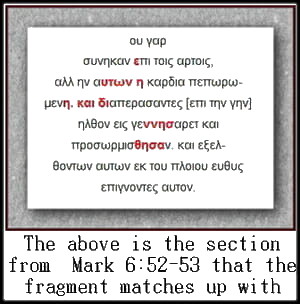 Of course, O’Callahan’s critics object to his identification and have tried to find other possibilities. The fragmentary nature of the ms. makes it difficult to be dogmatic about identifications. Nonetheless, O’Callahan offers a plausible, albeit revolutionary, possibility. If the identification of even one of these fragments as New Testament is valid, then the implications for Christian apologetics are enormous. It would be shown that the Gospel of Mark was written within the life time of the apostles and contemporaries of the events.
Of course, O’Callahan’s critics object to his identification and have tried to find other possibilities. The fragmentary nature of the ms. makes it difficult to be dogmatic about identifications. Nonetheless, O’Callahan offers a plausible, albeit revolutionary, possibility. If the identification of even one of these fragments as New Testament is valid, then the implications for Christian apologetics are enormous. It would be shown that the Gospel of Mark was written within the life time of the apostles and contemporaries of the events.
A date before A.D. 50 leaves no time for mythological embellishment of the records. They would have to be accepted as historical. It would also show Mark to be one of the earlier Gospels. Further, since these manuscripts are not originals but copies, it would reveal that the New Testament was “published”—copied and disseminated—during the life time of the writers. It would also reveal the existence of the New Testament canon during this early period, with pieces representing every major section of the New Testament: Gospels, Acts, and both Pauline and General Epistles.
The fragment of 2 Peter would argue for the authenticity of this often disputed epistle. The absence of fragments of John’s writings might indicate that they were written later (A.D. 80-90) in accordance with the traditional dates. With all these revolutionary conclusions it is little wonder that their authenticity is being challenged.
First-Century Jewish Messianic Expectations. The DSS have also yielded text that, while not referring to the Christ of the New Testament, have some interesting parallels, as well as some significant differences. The similarities that confirm the New Testament picture accurately describes Jewish expectation of a personal, individual Messiah who would die and rise from the dead. A fragment called “A Genesis Florilegorium” (4Q252) reflects belief in an individual Messiah who would be a descendant of David. “Column 5 (1) (the) Government shall not pass from the tribe of Judah. During Israel’s dominion, (2) a Davidic descendant on the throne shall [not cease . . until the Messiah of Righteousness, the Branch of (4) David comes” (see Eisenman, 89).
Even the deity of the Messiah is affirmed in the fragment known as “The Son of God” (4Q246), Plate 4, columns one and two: “Oppression will be upon the earth . . . [until] the King of the people of God arises, . . . and he shall become [gre]at upon the earth. [ . . . All w]ill make [peace,] and all will serve [him.] He will be called [son of the Gr]eat [God;] by His name he shall be designated. . . . He will be called the son of God; they will call him son of the Most High” (ibid., 70).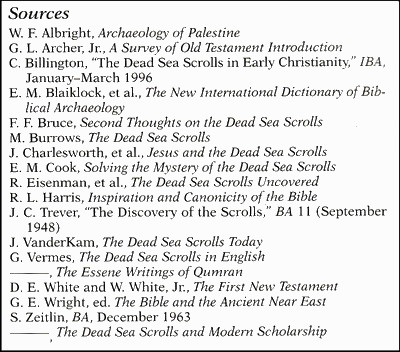
“The Messiah of Heaven and Earth” fragment (4Q521) even speaks of the Messiah raising the dead: “(12) then He will heal the sick, resurrect :he dead, and to the Meek announce glad tidings” (ibid., 23; cf. 63, 95).
The Dead Sea Scrolls also confirm that Qumran was not the source of early Christianity. There are significant differences between their concept of the “Teacher of Righteousness,” apparently an Essene messianic hope, and the Jesus revealed in Scripture and early Christianity. The differences are enough to show that early Christianity was not just an offshoot of the Essenes, as has been theorized (see Billing–ton, 8-10). The Essenes emphasized hating one’s enemies; Jesus stressed love. The Essenes were exclusivistic regarding women, sinners, and outsiders; Jesus was inclusive. The Essenes were legalistic sabbatarians; Jesus was not. The Essenes stressed Jewish purification laws; Jesus attacked them. The Essenes believed two messiahs would come; Christians held that Jesus was the only one (see Charlesworth).
Conclusion. The DSS provide an important apologetic contribution toward establishing the general reliability of the Old Testament Hebrew text, as well as the earliest copies of parts of Old Testament books and even whole books. This is important in showing that the predictive prophecies of the Old Testament were indeed made centuries before they were literally fulfilled. Furthermore, the DSS provide possible support for the New Testament. They may contain the earliest known fragments of the New Testament, and they definitely contain references to messianic beliefs similar to those taught in the New Testament.
Norman L. Geisler, Baker Encyclopedia of Christian Apologetics (Grand Rapids, MI: Baker Books/Academic, 1999), 188-189.
Take note as well that the earliest Church Fathers quoted Scripture… which would need to be completed and widely used by then:
- You write “All four gospels are quoted in patristic writings (a technical term which means writings by the early church “fathers.”) before AD 100 in books such as the Epistle of Barnabus, the book of Clement of Rome and the Didache.” There is nothing said about the four Gospels in the “Clement of Rome”. It is really pathetic that you must base supernatural ideas on false evidence and then you show this false evidence to the masses. I’d really like to get a response as to where I can find the gospels mention in the “Clement of Rome”. I’m curious to know what words you rummaged through to come up with this ridiculous accusation.
Answer:
I sense a lot of anger here. The use of words like “pathetic” and “ridiculous” are really not helpful if you want to engage in honest conversations. I want to encourage you to use a more respectful tone, even with those with whom you do not agree. In any case, I just gave a very quick little read of the Letter of Clement to Rome. I found a few quotations from the gospels as well as ones from the letters. Below is a sampling. Besides these, I found a number of allusions to the gospels and other New Testament Books. After each quote, I will have a very short comment.
1Clem 13:1 Let us therefore be lowly minded, brethren, laying aside all arrogance and conceit and folly and anger, and let us do that which is written. For the Holy Ghost saith, Let not the wise man boast in his wisdom, nor the strong in his strength, neither the rich in his riches; but he that boasteth let him boast in the Lord, that he may seek Him out, and do judgment and righteousness most of all remembering the words of the Lord Jesus which He spake, teaching forbearance and long-suffering.
This is a quote from 1 Corinthians 1:31
1Clem 13:2 for thus He spake Have mercy, that ye may receive mercy: forgive, that it may be forgiven to you. As ye do, so shall it be done to you. As ye give, so shall it be given unto you. As ye judge, so shall ye be judged. As ye show kindness, so shall kindness be showed unto you. With what measure ye mete, it shall be measured withal to you.
This is a quote from Matthew 7:2
1Clem 15:2 For He saith in a certain place This people honoreth Me with their lips, but their heart is far from Me.
This is quoting from either Matthew 15:8 or Mark 7:6
1Clem 16:1 For Christ is with them that are lowly of mind, not with them that exalt themselves over the flock.
This is an allusion to Luke 22:26 or Matthew 23:11
1Clem 34:8 For He saith, Eye hath not seen and ear hath not heard, and it hath not entered into the heart of man what great things He hath prepared for them that patiently await Him.
This is a quote from 1 Cor 2:9
1Clem 36:2 Through Him let us look steadfastly unto the heights of the heavens; through Him we behold as in a mirror His faultless and most excellent visage; through Him the eyes of our hearts were opened; through Him our foolish and darkened mind springeth up unto the light; through Him the Master willed that we should taste of the immortal knowledge Who being the brightness of His majesty is so much greater than angels, as He hath inherited a more excellent name. 1Clem 36:3 For so it is written Who maketh His angels spirits and His ministers aflame of fire 1Clem 36:4 but of His Son the Master said thus, Thou art My Son, I this day have begotten thee. Ask of Me, and I will give Thee the Gentiles for Thine inheritance, and the ends of the earth for Thy possession. 1Clem 36:5 And again He saith unto Him Sit Thou on My right hand, until I make Thine enemies a footstool for Thy feet.
These are quoting from Hebrews Chapter one….
Ignatius of Antioch would be another prime example.
Effectively the above information updates this older Josh McDowell graph here. In other words, we know the early history of Christianity because of the wealth of evidence behind certain events. For instance:
“Pharisaic Judaizers come down to Antioch (Acts 15:1, 5) in the late summer of 49 A.D. and teach that circumcision is necessary before a person can be saved. Paul, Barnabas, Titus and certain others (Galatians 2:1-2) are sent to Jerusalem to confer with other apostles, elders and brethren concerning the relationship between circumcision and salvation. This gathering is commonly referred to as the Jerusalem Conference. This conference occurs in the Fall of 49 A.D. around the time of the Feast of Tabernacles (Acts 15:2).”
We know this because of the evidence… the same evidence to say that two letters describing the eruption of Mount Vesuvius are considered history.
Buddhism lacks this historical attestation and predictive power that the New Testament has in that the original texts are much closer to the events that happened. In fact, the New Testament is superior to ALL ancient documents in this respect.
✞ “…but test all things. Hold on to what is good” (I Thessalonians 5:21);
✞ “Dear friends, do not believe every spirit, but test the spirits to determine if they are from God, because many false prophets have gone out into the world” (1 John 4:1);
✞ “Test yourselves to see if you are in the faith. Examine yourselves. Or do you yourselves not recognize that Jesus Christ is in you?—unless you fail the test[a]” (2 Corinthians 13:5 — [a] “unless you are disqualified” or “you are counterfeit”).


